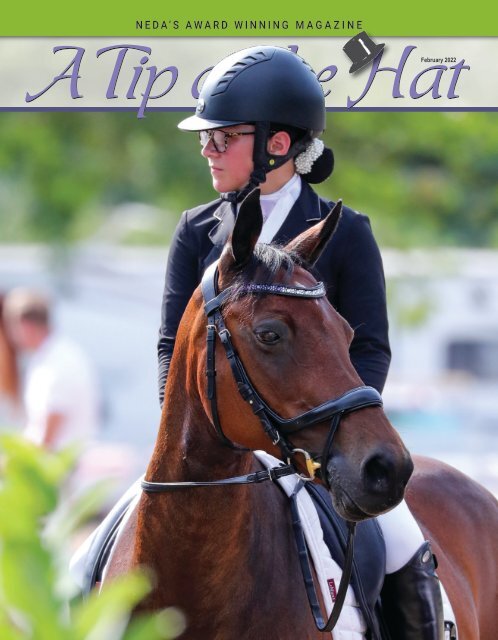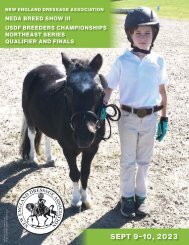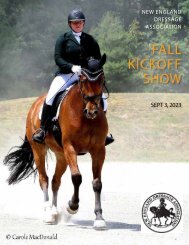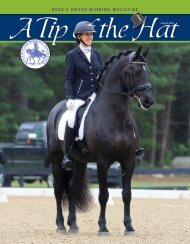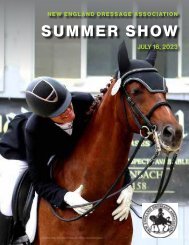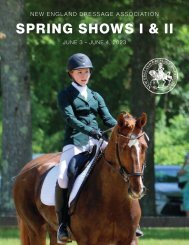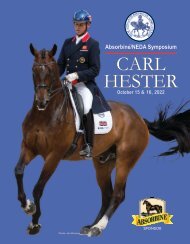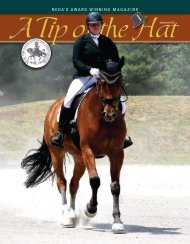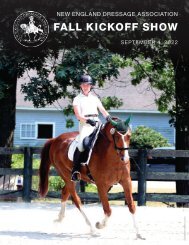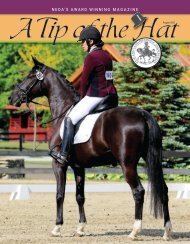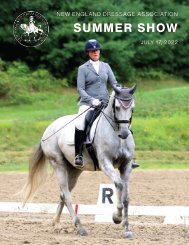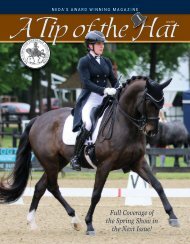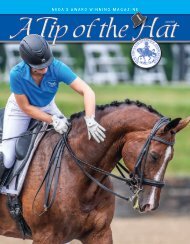NEDA A Tip of the Hat February 2022
New England Dressage Association's award winning magazine newsletter!
New England Dressage Association's award winning magazine newsletter!
You also want an ePaper? Increase the reach of your titles
YUMPU automatically turns print PDFs into web optimized ePapers that Google loves.
N E D A ’ S A W A R D W I N N I N G m A G A z I N E<br />
A<strong>Tip</strong> <strong>of</strong> <strong>the</strong> <strong>Hat</strong><br />
<strong>February</strong> <strong>2022</strong>
As I write this, <strong>2022</strong> is just a few<br />
hours old. I would love to say that<br />
2021 took <strong>the</strong> pandemic, hatred,<br />
poverty, climate crises, social<br />
unrest, and political strife with it but, alas, that’s<br />
not <strong>the</strong> case. Recognizing that my letter <strong>of</strong> a<br />
year ago wished for renewed healing across<br />
our realms <strong>of</strong> life, I’ll withhold <strong>the</strong> pixie dust. It<br />
didn’t work <strong>the</strong>n and, fearing being labelled<br />
crazy, I’ll assume it won’t work this time ei<strong>the</strong>r.<br />
Instead, let me tell you about Anthony<br />
Doerr’s Cloud Cuckoo Land, a novel that made<br />
it on to <strong>the</strong> New York Times 2021 Notable<br />
Books list and was a finalist for <strong>the</strong> 2021 National<br />
Book Award. At first, I thought <strong>the</strong> book<br />
weird. And it is. But as I got into it, I could not<br />
stop reading. It took me a while to catch on to<br />
<strong>the</strong> masterful weaving <strong>of</strong> <strong>the</strong> story across a tapestry<br />
<strong>of</strong> times and places that ties people toge<strong>the</strong>r<br />
because <strong>of</strong> <strong>the</strong>ir shared love <strong>of</strong> a book.<br />
It brings <strong>the</strong> past forward into <strong>the</strong> present,<br />
latching it to a future, through <strong>the</strong> eyes <strong>of</strong><br />
children. It enticingly speaks to past, present,<br />
future; to interconnectivity; to resilience. I hear<br />
you, now what is she rambling on about?<br />
As I think about <strong>the</strong> next year for <strong>NEDA</strong>,<br />
Cloud Cuckoo Land serves as a metaphor.<br />
<strong>NEDA</strong> has a rich history—this year we will be<br />
celebrating our 50th anniversary! <strong>NEDA</strong> was<br />
incorporated in 1972. It grew out <strong>of</strong> a trip by<br />
several equestriennes who had <strong>the</strong> opportunity<br />
to attend <strong>the</strong> 1968 Olympics in Mexico City and<br />
watch <strong>the</strong> dressage competition. They returned<br />
to New England determined to learn<br />
more about <strong>the</strong> sport. They connected with a<br />
handful <strong>of</strong> riders training in dressage, hosted<br />
informal clinics, practiced test rides, and put on<br />
small shows at <strong>the</strong> lower levels. When <strong>the</strong>y<br />
formed <strong>NEDA</strong> in 1972, <strong>the</strong>re were about 40<br />
members. Dressage was growing in popularity,<br />
and o<strong>the</strong>r organizations began to spring up<br />
across <strong>the</strong> country. The USDF was formed in<br />
1973 with <strong>NEDA</strong> as a founding member. From<br />
its early years, <strong>NEDA</strong> had a focus on education<br />
and brought in clinicians from all over <strong>the</strong> world<br />
to teach its members about both <strong>the</strong> art and<br />
sport <strong>of</strong> dressage. The education was put to<br />
<strong>the</strong> test in <strong>the</strong> competitions that <strong>NEDA</strong> organized,<br />
and <strong>the</strong> news and events were<br />
shared with members through The Salute and<br />
<strong>the</strong> <strong>Tip</strong> <strong>of</strong> <strong>the</strong> <strong>Hat</strong>.<br />
Today we are an organization <strong>of</strong> 1,200+<br />
members and USDF’s largest single-chapter<br />
GMO. We have created a portfolio <strong>of</strong> significant<br />
educational activities and competitions. We<br />
publish <strong>the</strong> OPL, seen in <strong>the</strong> hands <strong>of</strong> folks at<br />
every competition, and are proud <strong>of</strong> our awardwinning<br />
articles in <strong>the</strong> TIP. We support <strong>the</strong><br />
pipeline <strong>of</strong> USDF “L” judges through our Judge<br />
Education program. We have brought <strong>the</strong><br />
world’s top riders/trainers to our symposia. We<br />
host <strong>the</strong> <strong>NEDA</strong> Region 8 Championship and<br />
Fall Festival; a talked-about event <strong>of</strong> <strong>the</strong> year.<br />
And so much more.<br />
But <strong>the</strong> future will look different. The pandemic<br />
has caused financial hardships across<br />
<strong>the</strong> globe: <strong>NEDA</strong> was among <strong>the</strong> organizations<br />
that suffered increased costs, decreased revenues,<br />
and loss <strong>of</strong> membership. New options<br />
for education and competition are enjoying<br />
support—<strong>the</strong> <strong>NEDA</strong> Know-How virtual education<br />
series is a prime example. We have partnered<br />
with Ridely to <strong>of</strong>fer online support <strong>of</strong> your<br />
dressage training and education. We are exploring<br />
<strong>the</strong> option <strong>of</strong> virtual shows to provide<br />
members unable to leave <strong>the</strong>ir barns to get<br />
valuable feedback from top judges. Yet, because<br />
<strong>of</strong> decreased revenues, we are struggling<br />
to cover <strong>the</strong> administrative and<br />
member-benefit costs <strong>of</strong> <strong>the</strong> organization. Iris<br />
As <strong>the</strong> Board ponders our past, present,<br />
and future, we too weave a tapestry <strong>of</strong> experiences,<br />
expertise, ideas, possibilities, uncertainties,<br />
and perspectives. We are not always<br />
sure where to go or how to get <strong>the</strong>re. The debates<br />
are passionate. Sometimes <strong>the</strong> best we<br />
can do is try different approaches to see what<br />
works. But one thing is certain, things must<br />
change. We cannot maintain <strong>the</strong> status quo or<br />
we will not survive, and that is not an option.<br />
What we do know is that we have a dedicated<br />
Board, committed to carrying <strong>the</strong> <strong>NEDA</strong> torch<br />
into <strong>the</strong> next half-century and beyond. We also<br />
need your input. If you have ideas, please let<br />
us know. We need your voices and participation<br />
in laying out <strong>the</strong> future direction <strong>of</strong> <strong>the</strong> organization.<br />
If you have some time please volunteer;<br />
if you have an interest in working within <strong>the</strong> organization,<br />
consider a board or committee position.<br />
Most <strong>of</strong> all, we need your willingness and<br />
open mindedness to accept change – just as<br />
we are doing on <strong>the</strong> board. For any <strong>of</strong> <strong>the</strong>se,<br />
you can contact an event manager or a Board<br />
Executive. Please speak with us, your voice<br />
matters. <strong>NEDA</strong> does not operate as it did fifty<br />
years ago, nor will it look <strong>the</strong> same fifty years<br />
from now. The one thing that has not, and will<br />
not change, is our commitment to our members<br />
and our mission:<br />
to promote and support <strong>the</strong> Art and Sport<br />
<strong>of</strong> Dressage to <strong>the</strong> equestrian community<br />
for <strong>the</strong> purpose <strong>of</strong> fostering individual and<br />
collective growth by providing leadership,<br />
education, exhibitions, publications,<br />
competitions and to enhance greater<br />
public awareness, understanding, and<br />
appreciation for <strong>the</strong> discipline <strong>of</strong> Dressage.<br />
Call me crazy, but here’s <strong>the</strong> pixie dust. May<br />
<strong>2022</strong> bring you and all those you love, health,<br />
peace, and joy.<br />
Cheers<br />
Iris<br />
PRESIDENt’S PAGE<br />
<strong>NEDA</strong> is a<br />
Group Member<br />
Organization <strong>of</strong> USDF.<br />
Our members are<br />
automatically USDF<br />
Group members.<br />
<strong>February</strong> <strong>2022</strong> <strong>NEDA</strong>.ORG TIP OF THE HAT 3
A <strong>Tip</strong> <strong>of</strong> <strong>the</strong> <strong>Hat</strong><br />
Contents:<br />
3 President’s Page<br />
n Education News<br />
5 <strong>NEDA</strong> Fall Symposium 2021<br />
with Johann Hinnemann: Part 2<br />
11 Book Review: Ute Graf’s Effortless<br />
Dressage Program<br />
12 <strong>NEDA</strong> <strong>2022</strong> Stallion Auction<br />
12 Rider Fitness Goes Online and<br />
<strong>NEDA</strong> Member Goes with It<br />
14 <strong>NEDA</strong> Know-How Info<br />
15 Book Review Choke: What <strong>the</strong> secrets<br />
<strong>of</strong> <strong>the</strong> brain reveal...<br />
n Competition News<br />
16 Congratulations to <strong>NEDA</strong> Members<br />
Earning <strong>the</strong>se USDF Awards 2021<br />
18 Congratulations to <strong>NEDA</strong> Members<br />
on Their Placings in <strong>the</strong> 2021 USDF<br />
Year End Standings<br />
19 Scholarship Info<br />
20 <strong>NEDA</strong> Ka<strong>the</strong>rine McHugh Perpetual<br />
Trophy Winner<br />
21 2021 <strong>NEDA</strong> Year End Awards Pony<br />
n Sport Horse News<br />
22 USDF Breeder <strong>of</strong> Distinction Awards<br />
23 Broadfields 121 <strong>NEDA</strong> Dressage<br />
Sport Horse Breeding HIgh Score<br />
Perpetual Trophy<br />
n Membership News<br />
24 Hope Cooper Trains in Germany Cont’d<br />
25 Meet Helen van der Voort<br />
25 Membership Benefits<br />
26 Stallion Paddock<br />
A <strong>Tip</strong> <strong>of</strong> <strong>the</strong> <strong>Hat</strong> is a publication <strong>of</strong> The New England<br />
Dressage Association, Inc., a non-pr<strong>of</strong>it, tax exempt<br />
corporation.<br />
MEMBERSHIP QUESTIONS<br />
memberentry@neda.org<br />
A TIP OF THE HAT ADVERTISING<br />
Classified ads must be submitted to <strong>the</strong> Advertising<br />
Editor via email in plain text (.txt) or word (.doc).<br />
Display ads and photos may be submitted via email<br />
to <strong>the</strong> Advertising Editor. Ads must be high resolution,<br />
press ready PDFs with all images and fonts embedded<br />
or high resolution TIF, JPG or EPS, MS Word doc templates<br />
are available for your use at neda.org and can be<br />
converted to PDFs.<br />
All ads must be submitted to <strong>the</strong> Advertising Editor.<br />
Contact: Angela Prenosil,<br />
413-627-2699 ▲tipads@neda.org<br />
<strong>NEDA</strong> <strong>2022</strong> OFFICERS<br />
President:<br />
Iris Berdrow<br />
781-589-6422<br />
president@neda.org<br />
Vice President-Activities:<br />
Kate O’Connor<br />
508-612-6985<br />
vpactivities@neda.org<br />
Vice President-Services:<br />
Jennifer Dillon<br />
508-641-3121<br />
vpservices@neda.org<br />
Secretary:<br />
Hea<strong>the</strong>r Stone<br />
617-480-8077<br />
secretary@neda.org<br />
Treasurer:<br />
Cathy Liston<br />
207-572-6124<br />
treasurer@neda.org<br />
COORDINATORS<br />
and MANAGERS<br />
Education Coordinator and<br />
Judge Education Manager:<br />
Karen Roberts<br />
413-478-5671<br />
education@neda.org<br />
Judge Education Facilitator:<br />
Karry Bro<strong>the</strong>rs<br />
518-768-1233<br />
judgeed@neda.org<br />
Symposium Organizer:<br />
Beth Beukema<br />
508-320-6549<br />
fallsym@neda.org<br />
Competitions Coordinator:<br />
Beth Jenkins<br />
508-655-6490; 508-733-3672<br />
shows@neda.org<br />
Spring Show:<br />
Paul Cormier<br />
508-995-5988; 508-847-2931<br />
springshow@neda.org<br />
Schooling Shows Manager:<br />
Peter Chavonelle, Jr.<br />
schoolingshows@neda.org<br />
Sport Horse/Breed Shows:<br />
Kathy Hickerson<br />
603-673-4344; 603-557-4054<br />
sporthorse@neda.org<br />
Awards Coordinator:<br />
Cathy Liston<br />
awards@neda.org<br />
Year-End Awards:<br />
Viviane Pilicy<br />
yea@neda.org<br />
Follow us!<br />
@<strong>NEDA</strong>dressage<br />
#<strong>NEDA</strong>dressage<br />
COORDINATORS and MANAGERS<br />
SPONSORSHIP COMMITTEE<br />
Sponsorship Coordinator:<br />
Kari Cincotta<br />
781-654-7694<br />
sponsorship@neda.org<br />
Sponsor Facilitator:<br />
Open<br />
sponsorfacilitator@neda.org<br />
Sponsor Development:<br />
Open<br />
sponsordev@neda.org<br />
MEMBERSHIP COMMITTEE<br />
Membership Services Coordinator:<br />
Dawn Mackenzie<br />
518-657-1773<br />
membership@neda.org<br />
Board Recruitment:<br />
Open<br />
volunteer@neda.org<br />
Ombudsman:<br />
Lainey Johnson<br />
978-568-0523<br />
ombudsman@neda.org<br />
Member-at-Large:<br />
memberatlarge@neda.org<br />
Leslie de Grandmaison<br />
603-759-4642<br />
Sara Carlisle<br />
978-853-8163<br />
Public Relations Coordinator:<br />
Krista Nordgren<br />
207-749-6643<br />
pr@neda.org<br />
Photography:<br />
Carole MacDonald<br />
508-366-7886<br />
photo@neda.org<br />
A TIP OF THE HAT<br />
TIP Editor:<br />
Angela Prenosil<br />
413-627-2699<br />
<strong>Tip</strong>Editor@neda.org<br />
Graphic Design:<br />
June Evers<br />
845-294-0656<br />
jevers@warwick.net<br />
TIP Advertising:<br />
Angela Prenosil<br />
413-627-2699<br />
tipads@neda.org<br />
USDF REGION 8<br />
Regional 8 Director:<br />
Helen van der Voort<br />
region8dir@usdf.org<br />
Regional Youth Coordinator:<br />
Bobbi Carleton<br />
bobbicarleton@aol.com<br />
ADDITIONAL CONTACTS<br />
& OFF-BOARD ROLES<br />
Membership Services:<br />
Tammy Paparella<br />
978-257-1374<br />
region8dir@usdf.org<br />
Summer Show Manager:<br />
Paul Cormier<br />
508-995-5988; 508-847-2931<br />
springshow@neda.org<br />
Nor<strong>the</strong>ast Region OPL:<br />
Jennifer Dillon<br />
opl@neda.org<br />
Scholarships:<br />
Amy Bresky<br />
978-270-3880<br />
scholarships@neda.org<br />
Partners in Education Tier 1:<br />
Angela Prenosil<br />
413-627-2699<br />
edpartners1@neda.org<br />
Accountant:<br />
Carol Gordon<br />
774-225-8878<br />
accountant@neda.org<br />
Youth Liaison:<br />
Josie DeChaine<br />
413-464-4911<br />
youth@neda.org<br />
<strong>NEDA</strong> Stallion Auction, Recruitment:<br />
Open<br />
stallionrecruit@neda.org<br />
<strong>NEDA</strong> Stallion Auction:<br />
Amy Riley<br />
stallionauction@neda.org<br />
Cover: Finley Peterson with Mystic Max<br />
Photo: Susan Stickle<br />
4 TIP OF THE HAT <strong>NEDA</strong>.ORG <strong>February</strong> <strong>2022</strong>
<strong>NEDA</strong> Fall Symposium 2021<br />
with Johann Hinnemann<br />
October 23 & 24, 2021<br />
at Bear Spot Farm, Concord, MA<br />
PART TWO<br />
Prix St. George<br />
A<br />
PART ONE FEATURED IN JANUARY <strong>2022</strong><br />
BY GINA DAILEY<br />
fter each day’s lunch break,<br />
Ashley Madison was <strong>the</strong> first<br />
rider. We were treated to<br />
watching her ride Carol Lippa’s<br />
Bellissimo son Bella Mondo (“Bob”). The gorgeous<br />
gelding immediately showed <strong>the</strong> elastic<br />
and expressive gaits <strong>of</strong> a top-class horse. He<br />
was exciting to watch and displayed a character<br />
matching his athleticism.<br />
In <strong>the</strong> trot half pass, as with several <strong>of</strong> <strong>the</strong><br />
o<strong>the</strong>r horses, Jo wanted Ashley to come out <strong>of</strong><br />
<strong>the</strong> corner, pick her line, turn onto that line, and<br />
<strong>the</strong>n add <strong>the</strong> bend (haunches-in with Bob’s<br />
head facing <strong>the</strong> destination point). Most important<br />
is <strong>the</strong> trot quality: first <strong>the</strong> rhythm, <strong>the</strong>n<br />
<strong>the</strong> forwardness.<br />
In <strong>the</strong> extended walk, Jo said that <strong>the</strong> neck<br />
should get lower but not too low nor behind <strong>the</strong><br />
bit. The horse should look like he is eager to<br />
get to <strong>the</strong> end <strong>of</strong> <strong>the</strong> diagonal (or long side).<br />
They <strong>the</strong>n moved on to half steps, first asking<br />
from <strong>the</strong> walk and <strong>the</strong>n from <strong>the</strong> trot. You need<br />
to keep <strong>the</strong> forward sense at all times, because<br />
you can’t half halt if you don’t have <strong>the</strong> forwardness.<br />
The eventual goal is to be able to<br />
accordion from half steps to piaffe to half steps<br />
and to be able to control each step.<br />
Jo mentioned that it’s a luxury having a<br />
horse like Bob who wants to go forward. The<br />
rider must, however, be sure that <strong>the</strong> horse<br />
responds to <strong>the</strong> rebalancing aids. Bob’s trot<br />
is very good, with an excellent hind leg, and<br />
Jo complimented Ashley on her ability to influence<br />
<strong>the</strong> trot with her seat. She needs to<br />
do <strong>the</strong> same in <strong>the</strong> canter, which can be improved<br />
by using <strong>the</strong> canter pirouette. For <strong>the</strong><br />
pirouettes, <strong>the</strong>y started with working pirouettes<br />
around Jo, asking Bob to really bend his<br />
hocks. Ashley <strong>the</strong>n rode an almost on-<strong>the</strong>spot<br />
collected canter, transitioning to piaffe—<br />
Ashley Madison on Bella Mondo<br />
Jo says it’s all <strong>the</strong> same collection. When <strong>the</strong>y<br />
did a similar exercise <strong>the</strong> next day, Jo reminded<br />
everyone <strong>of</strong> how important it is when<br />
working at home to be very careful to feel<br />
when <strong>the</strong> horse is getting tired, because that’s<br />
when tendons can get injured.<br />
Jo had Ashley and Bob finish with one <strong>of</strong><br />
<strong>the</strong> exercises that he used for SanSi: cantering<br />
on <strong>the</strong> centerline and going forward for two<br />
strides, collecting, going forward again, collecting,<br />
doing a half pirouette, and <strong>the</strong>n going<br />
back in <strong>the</strong> opposite direction and repeating.<br />
After several repetitions, Jo asked Ashley to<br />
circle and let Bob canter long and low to finish<br />
<strong>the</strong> session.<br />
On <strong>the</strong> second day, Jo had Ashley work on<br />
very steep canter half passes to help her get<br />
<strong>the</strong> feel <strong>of</strong> <strong>the</strong> haunches being truly under <strong>the</strong><br />
horse, always with a walk and pat as soon as<br />
<strong>the</strong>y reached <strong>the</strong> long side. Bob’s canter left is<br />
better, but <strong>the</strong> steep half pass is harder for him<br />
to <strong>the</strong> left because he’s not strong enough. Jo<br />
had Ashley ride a shallower half pass in this direction<br />
to keep <strong>the</strong> integrity <strong>of</strong> <strong>the</strong> canter.<br />
Ashley gamely complied when Jo <strong>the</strong>n asked<br />
her to cross her stirrups for some flying<br />
changes, which Jo said would let her better feel<br />
how to make <strong>the</strong> changes more expressive.<br />
When <strong>the</strong>y moved on to <strong>the</strong> canter zig-zag,<br />
Jo was not satisfied with <strong>the</strong> flying changes and<br />
<strong>the</strong> second half passes, so he had Ashley ride<br />
a circle around him in haunches-in while he<br />
used an in-hand whip to get Bob’s inside hind<br />
leg more active and his hocks bending more.<br />
The rider must be sure that <strong>the</strong> bend and<br />
flexion are <strong>the</strong>re, and should only do five or six<br />
strides, walk, and repeat. Once again, Jo emphasized<br />
<strong>the</strong> need to give <strong>the</strong> horse a chance<br />
to brea<strong>the</strong>.<br />
On <strong>the</strong> first day, Ashley rode passage from<br />
piaffe, but on <strong>the</strong> second day Jo had her try it<br />
from walk. He said that’s one <strong>of</strong> <strong>the</strong> most difficult<br />
exercises, because you are going from a<br />
gait which has no impulsion to <strong>the</strong> movement<br />
with <strong>the</strong> most impulsion. Bob had not done<br />
passage transitions from walk before and got<br />
a bit excited at first, lifting his head and<br />
breaking into canter several times. Jo emphasized<br />
keeping everything simple for him;<br />
thinking just walk to trot, letting Bob relax, <strong>the</strong>n<br />
collecting <strong>the</strong> walk and asking him to go<br />
forward to passage.<br />
Intermediare<br />
David Collins on Shengli<br />
David Collins rode his handsome chestnut<br />
gelding Shengli. Shengli is light on his feet, ath-<br />
Continued →<br />
<strong>February</strong> <strong>2022</strong> <strong>NEDA</strong>.ORG TIP OF THE HAT 5<br />
EDUCAtION NEWS<br />
Photos: Carole MacDonald
letic, and very keen about his work. David and<br />
Shengli are competing at I-1 and schooling I-<br />
2. Jo said that a horse competing at this level<br />
should be a little rounder. He suggested using<br />
<strong>the</strong> snaffle rein more and keeping <strong>the</strong> curb rein<br />
looser. At <strong>the</strong> start <strong>of</strong> <strong>the</strong> warmup, Jo said that<br />
Shengli should use his back more and get his<br />
wi<strong>the</strong>rs up. With Jo’s help, Shengli improved<br />
throughout <strong>the</strong> session.<br />
While David worked on many short diagonals<br />
at both trot and canter, Jo emphasized<br />
<strong>the</strong> use <strong>of</strong> <strong>the</strong> bend in <strong>the</strong> corner and being<br />
careful about when to change <strong>the</strong> bend. As with<br />
many <strong>of</strong> <strong>the</strong> previous riders, Jo had David work<br />
on trot-canter-trot transitions on a circle but<br />
added leg yielding out during <strong>the</strong> downward<br />
transitions to make <strong>the</strong> transitions smoo<strong>the</strong>r.<br />
For <strong>the</strong> canter-walk-canter work on a circle, Jo<br />
wanted more snaffle rein. Next <strong>the</strong>y brought<br />
<strong>the</strong> circle smaller at <strong>the</strong> canter, flexing to <strong>the</strong><br />
inside and bringing <strong>the</strong> haunches in, while<br />
being sure to keep <strong>the</strong> front end on <strong>the</strong> line <strong>of</strong><br />
<strong>the</strong> circle.<br />
David next worked on short diagonals in<br />
<strong>the</strong> canter with no flying change at <strong>the</strong> end. Jo<br />
had David stay in counter-canter and keep <strong>the</strong><br />
canter small to help get <strong>the</strong> hind legs under <strong>the</strong><br />
horse. In a good flying change, it should feel<br />
like <strong>the</strong> bascule <strong>of</strong> a show jumper. As David<br />
had been a show jumper in Europe, he appreciated<br />
that comment, because <strong>the</strong> way Jo had<br />
David’s horse cantering did in fact remind him<br />
<strong>of</strong> a jumper’s bascule. Jo asked “It’ a different<br />
canter for you now, yes?” and was met with<br />
David’s emphatic “Yes!” When <strong>the</strong>y moved on<br />
to four-tempi changes, Shengli threw in some<br />
two-tempis. Jo said he might be getting a bit<br />
tired from all <strong>the</strong> work on going rounder, so <strong>the</strong>y<br />
stopped for <strong>the</strong> day.<br />
On <strong>the</strong> second day, Jo was pleased with<br />
how Shengli started out. The horse seemed<br />
to be picking up from where <strong>the</strong>y had left <strong>of</strong>f<br />
<strong>the</strong> previous day and already was moving<br />
better. They worked again on <strong>the</strong> trot-cantertrot<br />
transitions on <strong>the</strong> circle, with Jo wanting<br />
to see a visible half halt before <strong>the</strong> upward<br />
transitions. Jo noted that more outside rein<br />
contact was needed so that <strong>the</strong> horse’s spine<br />
follows <strong>the</strong> line <strong>of</strong> <strong>the</strong> circle. They moved on<br />
to cantering on <strong>the</strong> centerline. Jo was not satisfied<br />
with Shengli’s first turn onto <strong>the</strong> center<br />
line, and he explained that during <strong>the</strong> turn<br />
David should think <strong>of</strong> shoulder-in and push<br />
<strong>the</strong> haunches out.<br />
When working on medium and extended<br />
trot on <strong>the</strong> diagonal, Jo emphasized <strong>the</strong> importance<br />
<strong>of</strong> not allowing <strong>the</strong> horse to raise his neck<br />
and lower his back as he leng<strong>the</strong>ns. David and<br />
Shengli also worked on Jo’s familiar exercise<br />
<strong>of</strong> haunches-in on <strong>the</strong> long side before <strong>the</strong> trot<br />
half pass, with Jo noting that you can’t get<br />
shoulder freedom without hind-end activity.<br />
When asked about <strong>the</strong> piaffe work, David<br />
said that he usually starts in hand. He dismounted<br />
and fastened <strong>the</strong> outside rein to <strong>the</strong><br />
girth, to Jo’s approval. Jo usually employs side<br />
reins to serve <strong>the</strong> same purpose and said that<br />
too <strong>of</strong>ten he sees people working in hand with<br />
very loose reins and <strong>the</strong>y can’t keep <strong>the</strong> horse<br />
straight. Once David started <strong>the</strong> piaffe work, Jo<br />
instructed him to concentrate on <strong>the</strong> rhythm<br />
first, <strong>the</strong>n to allow a little bit <strong>of</strong> forward<br />
movement. When David remounted, Jo had<br />
him trot first before helping with <strong>the</strong> piaffe from<br />
<strong>the</strong> ground. He encouraged David to keep his<br />
upper body a little bit forward to get <strong>the</strong> weight<br />
<strong>of</strong>f <strong>the</strong> horse’s back, enabling Shengli to swing<br />
more freely through his back.<br />
When David and Shengli returned to <strong>the</strong><br />
canter work, Jo emphasized <strong>the</strong> need to<br />
create power in <strong>the</strong> canter for <strong>the</strong> pirouettes<br />
and <strong>the</strong> flying changes. In <strong>the</strong> tempi changes,<br />
one should renew <strong>the</strong> canter between each<br />
change. To create <strong>the</strong> increased power, Jo<br />
had <strong>the</strong>m work on haunches-in on <strong>the</strong> circle<br />
and also canter circles with <strong>the</strong> canter almost<br />
on <strong>the</strong> spot.<br />
Grand Prix<br />
Bobbi Carleton rode Roxanne Bok’s Espumante,<br />
a lovely, super elastic, and plucky<br />
grey Lusitano with a lot <strong>of</strong> heart. During <strong>the</strong>ir<br />
warmup, Jo said that <strong>the</strong> trot needed to be<br />
more rhythmical and cadenced. He said it had<br />
taken him a long time to understand cadence<br />
and was enlightened after reading a judge’s<br />
comment that Jo’s horse “just turns <strong>the</strong><br />
shavings.” Jo said that Bobbi’s horse needed<br />
to march, lift his legs and nearly passage,<br />
showing more swing. Once you get lift and cadence,<br />
you can ask him to go more forward but<br />
only to <strong>the</strong> extent that he can still maintain <strong>the</strong><br />
cadence. To develop more cadence, Jo had<br />
<strong>the</strong>m work on trot leg yields across <strong>the</strong> arena.<br />
Because <strong>the</strong> canter departures needed to<br />
be more uphill, Jo had Bobbi work on transitions<br />
between collected canter and canter-on<strong>the</strong>-spot<br />
on <strong>the</strong> long side and <strong>the</strong>n on <strong>the</strong><br />
centerline. He explained that in <strong>the</strong> Grand Prix<br />
HINNEMANN- cont’d<br />
Bobbi Carleton with Espumante<br />
Photo: Carole MacDonald<br />
test, <strong>the</strong> canter centerline accounts for five<br />
marks (two for each pirouette and one for <strong>the</strong><br />
flying change in between), so you really need<br />
to have <strong>the</strong> control that <strong>the</strong> canter-on-<strong>the</strong>-spot<br />
teaches you. He also pointed out that you can’t<br />
school a thousand pirouettes, but it’s okay to<br />
school lots <strong>of</strong> canter-on-<strong>the</strong>-spot.<br />
In <strong>the</strong> piaffe, Jo told Bobbi to be careful not<br />
to let Espumante drop his neck. It’s okay to<br />
compromise and let <strong>the</strong> neck get a little bit<br />
short so long as <strong>the</strong> poll is <strong>the</strong> highest point. He<br />
had <strong>the</strong>m piaffe, go a little bit forward, piaffe<br />
again, and repeat several times. The horse<br />
started to relax and brea<strong>the</strong>. Jo advised Bobbi<br />
to think almost rein back in <strong>the</strong> piaffe so that<br />
<strong>the</strong> horse doesn’t go forward when she’s not<br />
asking him to. In <strong>the</strong> passage, he said that her<br />
horse needed to go more forward but not too<br />
Continued →<br />
<strong>February</strong> <strong>2022</strong> <strong>NEDA</strong>.ORG TIP OF THE HAT 7
HINNEMANN- cont’d<br />
much. He also recommended <strong>the</strong> use <strong>of</strong> lots <strong>of</strong><br />
halts during piaffe and passage to give <strong>the</strong><br />
horse a chance to brea<strong>the</strong>. The passage improved<br />
and <strong>the</strong> horse was quicker to get into<br />
<strong>the</strong> rhythm and able to stay <strong>the</strong>re a bit longer,<br />
but Jo cautioned not to do more than six or<br />
seven strides at a time so that <strong>the</strong> horse remains<br />
relaxed.<br />
On <strong>the</strong> second day, <strong>the</strong>y started <strong>the</strong> session<br />
in canter (Bobbi had already trotted outside in<br />
<strong>the</strong> warm-up arena) and right away had a<br />
much more energetic and better canter than<br />
<strong>the</strong> previous day. They worked on medium<br />
canter and followed with tempi changes, which<br />
Jo noted were starting to come through <strong>the</strong><br />
horse’s back much better. They did <strong>the</strong> basic<br />
canter-walk-canter work on <strong>the</strong> circle and Jo<br />
said that when Bobbi does this at home, she<br />
should be sure to get <strong>the</strong> correct canter each<br />
time so that <strong>the</strong> horse develops <strong>the</strong> right<br />
muscles. To help improve <strong>the</strong> canter, <strong>the</strong>y<br />
worked on a canter circle, halt (or two tiny walk<br />
strides, which seemed to work better for this<br />
pair), <strong>the</strong>n into canter-on-<strong>the</strong>-spot.<br />
Bobbi practiced <strong>the</strong> extended canter exercise<br />
several times, where she transitioned to<br />
walk before finishing <strong>the</strong> diagonal. Jo said <strong>the</strong>y<br />
should do <strong>the</strong>ir extensions this way at home<br />
and work on extensions in between collected<br />
work. Jo said that Espumante, in particular,<br />
needs this exercise since he likes to get strong<br />
and come against <strong>the</strong> rider’s hand. Likewise,<br />
in <strong>the</strong> half pirouettes he tries to take over and<br />
do full pirouettes, so it’s important to control <strong>the</strong><br />
movement and break it down into quarter<br />
pirouettes, <strong>the</strong>n a quarter plus a half pirouette,<br />
and ultimately a full pirouette. While working on<br />
walk pirouettes, Jo noted <strong>the</strong> importance <strong>of</strong><br />
controlling <strong>the</strong> neck to help <strong>the</strong> hind end.<br />
For <strong>the</strong> piaffe work, <strong>the</strong>y started in walk, did<br />
two steps <strong>of</strong> piaffe, walked, did two steps <strong>of</strong><br />
piaffe, etc. This was much more relaxed than<br />
<strong>the</strong> piaffe work <strong>the</strong> previous day. To help keep<br />
<strong>the</strong> piaffe relaxed, <strong>the</strong>y also did half steps,<br />
maintaining <strong>the</strong> relaxation, <strong>the</strong>n into piaffe, with<br />
a relaxed walk in between each attempt. Jo<br />
was pleased with <strong>the</strong> second day’s piaffe work,<br />
commenting that as he had expected <strong>the</strong><br />
knees were no longer up too high, and <strong>the</strong><br />
horse’s hocks were no longer out behind him.<br />
At various points throughout <strong>the</strong> symposium,<br />
especially when <strong>the</strong> horse in <strong>the</strong> ring<br />
was taking a walk break, Jo shared o<strong>the</strong>r<br />
8 TIP OF THE HAT <strong>NEDA</strong>.ORG <strong>February</strong> <strong>2022</strong><br />
training tips. He discussed <strong>the</strong> different types<br />
<strong>of</strong> trot: working trot where <strong>the</strong> hind feet should<br />
step into <strong>the</strong> footprints <strong>of</strong> <strong>the</strong> front feet, collected<br />
trot where <strong>the</strong>y step behind <strong>the</strong> footprints<br />
<strong>of</strong> <strong>the</strong> front, and medium or extended<br />
trot where <strong>the</strong> hind feet step beyond <strong>the</strong> footprints<br />
<strong>of</strong> <strong>the</strong> front feet.<br />
Jo talked about <strong>the</strong> importance <strong>of</strong> <strong>the</strong> rider<br />
having supple wrists. If you press your thumbs<br />
down flat against <strong>the</strong> reins and your index<br />
finger (as so many riders are taught to do), it<br />
makes your wrist stiff. Instead, you should<br />
press <strong>the</strong> tip <strong>of</strong> your thumb against your index<br />
finger and keep <strong>the</strong> thumb joint bent.<br />
On a more global point, Jo said that riders<br />
should be willing to make mistakes. For example,<br />
push for more activity in <strong>the</strong> walk—if <strong>the</strong><br />
horse starts to jig, you’ve learned how far is too<br />
far to push.<br />
Several <strong>of</strong> <strong>the</strong> symposium riders mentioned<br />
after <strong>the</strong>ir rides that <strong>the</strong>y had found Jo to be extremely<br />
helpful. There was nothing startling in
Johann with Jane Karol. Photo: Carole MacDonald<br />
his system: no “magic fixes,” no “smoke and<br />
mirrors,” just a confirmation <strong>of</strong> <strong>the</strong> importance<br />
<strong>of</strong> attention to <strong>the</strong> basics and solidifying <strong>the</strong>ir<br />
confidence in how <strong>the</strong>y’ve been training <strong>the</strong>ir<br />
horses. Ashley appreciated <strong>the</strong> emphasis on<br />
being fair to <strong>the</strong> horse while also knowing when<br />
it’s okay to push for more. Having been especially<br />
careful with <strong>the</strong> piaffe/passage work, she<br />
HINNEMANN- cont’d<br />
found it encouraging to hear that Bob is ready<br />
for her to ask for more. Similarly, Mary said that<br />
it was nice to hear Jo suggest she keep her<br />
mare rounder—everyone says to ride <strong>the</strong>m “up<br />
and out” when <strong>the</strong>y are young, but Dramatique<br />
is now at <strong>the</strong> point where she needs to work<br />
with more roundness.<br />
Throughout <strong>the</strong> Symposium, Jo was a<br />
stickler for not accepting anything less than<br />
<strong>the</strong> correct response, but he always made<br />
sure to take time to let <strong>the</strong> horse relax and regroup<br />
when necessary. He was firm and exacting<br />
with <strong>the</strong> riders while always being kind<br />
to <strong>the</strong> horses.<br />
Many thanks to Jane Karol and <strong>the</strong> entire<br />
team at Bear Spot Farm for hosting this very<br />
educational weekend, to <strong>NEDA</strong> for bravely organizing<br />
<strong>the</strong>ir first, in-person, educational<br />
event since <strong>the</strong> start <strong>of</strong> <strong>the</strong> pandemic and, <strong>of</strong><br />
course, to Johann Hinnemann for all <strong>of</strong> his<br />
many insights.<br />
<strong>February</strong> <strong>2022</strong> <strong>NEDA</strong>.ORG TIP OF THE HAT 9
BOOK REVIEW<br />
Ute Graf’s Effortless<br />
Dressage Program<br />
BY UTE GRAF & FRIEDERIKE HEIDENHOF<br />
EDUCAtION NEWS<br />
REVIEWED BY SUZY FRASER<br />
“Effortless Dressage” seems like a misnomer<br />
at first glance, because every<br />
dressage rider knows just how much hard<br />
work dressage entails. But, Graf clarifies <strong>the</strong><br />
meaning <strong>of</strong> “effortless” in <strong>the</strong> book’s preface,<br />
saying, “Effortless riding doesn’t simply mean<br />
sitting up <strong>the</strong>re and resting. It is much more<br />
about balance, body coordination, and constantly<br />
refining <strong>the</strong> effectiveness <strong>of</strong> <strong>the</strong> aids.<br />
It also means working toward using less force<br />
when riding.”<br />
Effortless riding is not just <strong>the</strong> physical<br />
aspects <strong>of</strong> <strong>the</strong> sport ei<strong>the</strong>r: it is a mindset as<br />
Graf explains in <strong>the</strong> section titled “Effortless<br />
Riding Starts in Your Head.” Along with<br />
learning <strong>the</strong> mechanics <strong>of</strong> riding, gaining <strong>the</strong><br />
required physical fitness, and understanding<br />
riding <strong>the</strong>ory, we also have to approach riding<br />
with <strong>the</strong> right attitude.<br />
The key to effortless riding starts with<br />
motivating <strong>the</strong> horse by making <strong>the</strong> work fun<br />
and comfortable. Although this is logical, it’s<br />
easy to override a horse, especially when not<br />
getting <strong>the</strong> desired response. We want to instill<br />
in our horses an eager willingness and encourage<br />
<strong>the</strong>m to find <strong>the</strong>ir own balance—in<br />
o<strong>the</strong>r words, give <strong>the</strong>m some independence<br />
ra<strong>the</strong>r than dictating every step. Graf reminds<br />
<strong>the</strong> reader that horses are telepathic, so we<br />
must be very clear with <strong>the</strong> mental images<br />
and thoughts we are conveying.<br />
Holding <strong>the</strong> horse toge<strong>the</strong>r and constantly<br />
pushing are <strong>the</strong> anti<strong>the</strong>sis <strong>of</strong> effortless riding.<br />
In addition to being exhausting for <strong>the</strong> rider,<br />
<strong>the</strong> horse will likely break stride if <strong>the</strong> aids are<br />
removed for even a moment. The horse must<br />
be taught to keep going until <strong>the</strong> rider says<br />
o<strong>the</strong>rwise, which is why <strong>the</strong> refinement <strong>of</strong> <strong>the</strong><br />
rider’s aids is critical. It is <strong>the</strong> only way <strong>the</strong><br />
horse will learn to respond to <strong>the</strong> lightest aids<br />
which is at <strong>the</strong> heart <strong>of</strong> effortless riding. To<br />
achieve this, <strong>the</strong> horse is rewarded for his response<br />
to <strong>the</strong> aid. The rider <strong>the</strong>n consciously<br />
starts reducing <strong>the</strong> aid with <strong>the</strong> expectation <strong>of</strong><br />
<strong>the</strong> same response, and quickly rewards <strong>the</strong><br />
correct answer. As is always <strong>the</strong> case when<br />
training horses, patient and consistent repetition<br />
are essential.<br />
Throughout this well-written book, Graf<br />
provides advice on how to achieve <strong>the</strong><br />
harmony and effortlessness we see in top<br />
riders throughout <strong>the</strong> world based on her own<br />
extensive experience training and competing.<br />
In addition, Graf provides <strong>the</strong> reader with<br />
case studies <strong>of</strong> several horses she has in<br />
training, going into detail regarding <strong>the</strong>ir<br />
strengths and weaknesses and how she addresses<br />
each. Excellent photographs complement<br />
<strong>the</strong> text.<br />
“Effortless Dressage Program” is a musthave<br />
in any rider’s library, from <strong>the</strong> casual<br />
rider to <strong>the</strong> international competitor. Graf is<br />
reassuring, as she urges riders to learn from<br />
mistakes ra<strong>the</strong>r than doubting <strong>the</strong>ir ability,<br />
and she goes into detail on <strong>the</strong> mental state<br />
needed to compete successfully, <strong>of</strong>fering a<br />
number <strong>of</strong> valuable insights. In addition to test<br />
riding tips, she shares advice on emergency<br />
measures within a test—something that<br />
anyone riding down <strong>the</strong> centerline will find<br />
useful at some point.<br />
<strong>February</strong> <strong>2022</strong> <strong>NEDA</strong>.ORG TIP OF THE HAT 11
MEMBER NEWS<br />
Rider Fitness Goes Online<br />
and <strong>NEDA</strong> Member Goes with It<br />
Carusone is Fitness Expert for Ridely App<br />
EDUCAtION NEWS<br />
Can you guess which part <strong>of</strong><br />
<strong>the</strong> fitness industry experienced<br />
<strong>the</strong> greatest growth over <strong>the</strong> last<br />
two years?<br />
If you are streaming workouts from what<br />
used to be your dining room, you know <strong>the</strong><br />
answer. And if your dining room is still a dining<br />
room? You can probably guess <strong>the</strong> answer.<br />
Since 2019, <strong>the</strong> global online fitness industry<br />
has grown 77 percent into a $10 billion<br />
dollar behemoth. It is projected to grow 30<br />
percent annually over <strong>the</strong> next several years.<br />
Consumer spending on traditional gym memberships<br />
has declined steadily since 2016.<br />
These are not new trends; <strong>the</strong> COVID pandemic<br />
simply accelerated <strong>the</strong>m, transforming<br />
<strong>the</strong> fitness industry – and your dining room.<br />
So, if you are an aspiring rider, like I am,<br />
what does this mean for your own fitness<br />
program? And if you provide fitness training<br />
to riders like I do, what happens next? In<br />
ei<strong>the</strong>r case, you look for a solution, experimenting<br />
with new ideas until you find <strong>the</strong> right<br />
thing. And for me, in 2021, Ridely was that<br />
right thing.<br />
In March 2020, my personal training and<br />
Pilates business went 100 percent virtual literally<br />
overnight. One day I was working from<br />
my gym. The next, I was training clients from<br />
my dining room. Even after a return to inperson<br />
training, how I work with clients now<br />
is quite different from what I was doing just<br />
two years ago. However, some things<br />
remain <strong>the</strong> same; riders are motivated by<br />
fitness programming that meets <strong>the</strong>ir specific<br />
needs as athletes and that reflects <strong>the</strong><br />
unique requirements <strong>of</strong> <strong>the</strong>ir sport.<br />
Since early 2020, <strong>the</strong> way in which I<br />
consume training as an athlete and as a rider<br />
changed dramatically as well. When my<br />
trainer’s boxing gym closed, I worked with<br />
him virtually. I used <strong>the</strong> power <strong>of</strong> technology<br />
to support my riding as well. From my barn<br />
in Massachusetts, I could work with a top<br />
dressage trainer based in Florida simply<br />
and easily. Perhaps you did <strong>the</strong> same thing.<br />
Like you, I could tell that working this way<br />
was going to become even easier and even<br />
more popular.<br />
In 2019, I had no idea what <strong>the</strong> new year<br />
would bring. All I knew that I needed to respond<br />
to <strong>the</strong> shift in <strong>the</strong> fitness industry with<br />
a solid online strategy. I wanted my response<br />
to accomplish three things. First, I<br />
wanted to <strong>of</strong>fer engaging online training, delivering<br />
<strong>the</strong> specialized training/movement<br />
solutions I am known for in a way that let<br />
users share, capture, and track <strong>the</strong>ir<br />
progress. Second, I wanted to expand my<br />
business without opening and staffing a<br />
new location. And finally, I really wanted to<br />
reduce my business travel.<br />
Lisa Carusone. Photo: John Carusone<br />
I was already experimenting with making<br />
technology a bigger part <strong>of</strong> my business. I<br />
created custom videos for clients who<br />
wanted to keep training between gym visits.<br />
I used FaceTime to guide rider clients<br />
through pre-show warm up sessions<br />
wherever <strong>the</strong>y happened to be showing.<br />
However, <strong>the</strong>se approaches lacked a reliable<br />
way to share, capture and track user<br />
progress. Nor were <strong>the</strong>y scalable.<br />
When I work with someone one-on-one,<br />
sharing, capturing, and tracking client<br />
progress is really about <strong>the</strong> discipline <strong>of</strong> updating<br />
client records after each training<br />
session and reviewing <strong>the</strong>m before <strong>the</strong> next<br />
session. When I work with clients who ride,<br />
<strong>the</strong> challenge is a bit different. I become<br />
part <strong>of</strong> a team <strong>of</strong> four; me, my client <strong>the</strong><br />
rider, <strong>the</strong> rider’s horse and <strong>the</strong> trainer who<br />
works with <strong>the</strong> rider/horse combination.<br />
The biggest challenge? How all <strong>of</strong> us can<br />
share, capture, and track rider and horse<br />
progress. I have tried any number <strong>of</strong> approaches<br />
and can tell you that group texts<br />
are not <strong>the</strong> answer.<br />
Continued →<br />
<strong>February</strong> <strong>2022</strong> <strong>NEDA</strong>.ORG TIP OF THE HAT 13
RIDELY- cont’d<br />
Given what I do, I am constantly looking<br />
at and evaluating fitness apps. As I revised<br />
my business goals from 2019 to reflect<br />
changes to my business and my athletic<br />
/riding life that happened in 2020-2021, I<br />
took a more comprehensive and critical look<br />
at fitness apps, to see if <strong>the</strong>re was a tool already<br />
available that might work for me.<br />
There is some terrific material available<br />
online for those <strong>of</strong> us who ride. However, I<br />
was challenged to find a single app specifically<br />
for riders that <strong>of</strong>fered that elusive combination<br />
<strong>of</strong> engaging content, including fitness,<br />
and a way to share, capture and track user<br />
progress. A few <strong>of</strong> <strong>the</strong>se apps had real<br />
problems with <strong>the</strong> reliability <strong>of</strong> <strong>the</strong>ir platform<br />
while o<strong>the</strong>rs looked very much like <strong>the</strong>y were<br />
still in <strong>the</strong> early stages <strong>of</strong> development.<br />
Then, one <strong>of</strong> my clients told me about<br />
Ridely.<br />
At <strong>the</strong> time I registered for my Ridely free<br />
trial, <strong>the</strong> app <strong>of</strong>fered a variety <strong>of</strong> tightly focused<br />
beautifully produced videos from<br />
well-known European trainers primarily in<br />
dressage and show jumping. It also <strong>of</strong>fered<br />
a way for me to set goals and track<br />
progress in my own riding. The app held me<br />
accountable, prompting me for follow up if I<br />
had not logged my scheduled activities.<br />
Best <strong>of</strong> all, I had <strong>the</strong> option <strong>of</strong> connecting<br />
with my trainer through <strong>the</strong> app to share activities,<br />
progress, and feedback. So no more<br />
scribbled notes or text messages back and<br />
forth. From what I could tell, Ridely looked<br />
like a terrific solution to what I was after.<br />
Except for one thing. It lacked a fitness<br />
component.<br />
Flash forward to August 26, 2021. I spent<br />
<strong>the</strong> better part <strong>of</strong> that day with Nicole Graf,<br />
U.S. Country Manager for Ridely, filming<br />
rider fitness videos at my gym. Over <strong>the</strong><br />
course <strong>of</strong> several months, Ridley will release<br />
11 <strong>of</strong> my videos in total, where I cover<br />
topics like building rider biomechanics<br />
through <strong>the</strong> core, balance for riders, mobility<br />
for riders, and pre-ride warmups everyone<br />
can do. The app is even more robust than<br />
ever, <strong>of</strong>fering content for riders <strong>of</strong> all disciplines<br />
from some <strong>of</strong> <strong>the</strong> sports top pr<strong>of</strong>essionals.<br />
And as Ridely’s fitness expert, I<br />
have a way <strong>of</strong> meeting business goals I set<br />
in 2019. Not a bad way to come through a<br />
pandemic.<br />
About <strong>the</strong> author:<br />
Lisa Carusone, NBC-HWC, NASM-CPT/CES,<br />
is a personal trainer and a classically trained<br />
Pilates instructor as well as a Duke Integrative<br />
Medicine trained Integrative Health Coach.<br />
She is a National Board-Certified Health and<br />
Wellness Coach. Lisa <strong>of</strong>fers in-person and<br />
virtual private and semi-private fitness<br />
training, along with in-person and virtual<br />
private and small group Integrative Health<br />
Coaching, at her gym and <strong>of</strong>fice in Waltham,<br />
MA. Lisa travels for clinics.<br />
Find her online at LisaCarusone.com or on<br />
Instagram at LisaCarusoneFitnessOfficial.<br />
<strong>NEDA</strong> KNOW-HOW WEEKLY WEBINAR SERIES<br />
<strong>NEDA</strong> KNOW-HOW<br />
IS BACK!<br />
Every Thursday night<br />
in Jan., Feb., & March<br />
It’s FREE!<br />
Need more info:<br />
membership@neda.org<br />
SCAN HERE<br />
FOR INFO<br />
AND LINK TO<br />
SCHEDULE<br />
Carl Hester image: Jon Stroud<br />
14 TIP OF THE HAT <strong>NEDA</strong>.ORG <strong>February</strong> <strong>2022</strong>
Choke: What <strong>the</strong> secrets <strong>of</strong> <strong>the</strong><br />
brain reveal about getting it<br />
right when you have to.<br />
BY SIAN BEILOCK, PHD FREE PRESS, 2010<br />
REVIEWED BY IRIS BERDROW<br />
Ican’t remember how this book came<br />
across my radar screen, but I do remember<br />
when—right after I choked<br />
during my championship class at USDF<br />
National Finals in November 2021. I had<br />
ridden that test, at home, at away shows, and<br />
at Regional Championships. But, when it really<br />
counted, I went <strong>of</strong>f course—TWICE! I choked.<br />
So, this book is personal for me. I want to<br />
entice o<strong>the</strong>rs to read it, whe<strong>the</strong>r you are calm<br />
and focused all <strong>the</strong> time, none <strong>of</strong> <strong>the</strong> time, or<br />
some <strong>of</strong> <strong>the</strong> time. And especially if you train<br />
o<strong>the</strong>rs who are prone to losing <strong>the</strong>ir composure<br />
when it matters.<br />
Beilock defines choking as, “suboptimal<br />
performance” in something you are capable <strong>of</strong><br />
doing and have done well in <strong>the</strong> past, “in response<br />
to a highly stressful situation.” He relates<br />
this phenomenon to all types <strong>of</strong><br />
performance—academic, athletic, and pr<strong>of</strong>essional.<br />
If you are someone who needs scientific<br />
pro<strong>of</strong> <strong>of</strong> <strong>the</strong> phenomenon and its root<br />
causes, <strong>the</strong> book delivers. But you can also<br />
skip right to <strong>the</strong> nitty gritty—what happens and<br />
how do I prevent it from happening?<br />
There are two particularly salient chapters,<br />
Chapter Six: The Choking Cure, and Chapter<br />
Eight: Antichoke Techniques. I like <strong>the</strong>se because<br />
key points are summarized at <strong>the</strong> end<br />
<strong>of</strong> both chapters, a Cliff Notes version for us<br />
busy folks. Here are Beilock’s suggestions interspersed<br />
with my interpretations <strong>of</strong> how<br />
<strong>the</strong>se points relate to our sport1.<br />
<strong>Tip</strong>s to Ensure Success<br />
Under Stress – i.e., what to<br />
do before <strong>the</strong> test<br />
BOOK REVIEW<br />
n Reaffirm your self-worth. Keep a journal<br />
that includes a section, things I do well. This is<br />
a practice Meredith Brisson encourages in her<br />
Mental Half Halt Program. We spend so much<br />
time focusing on what is not working that we<br />
forget <strong>the</strong> many things we can do. Be specific—mounting<br />
your horse, riding deep<br />
corners, balancing your horse through transitions.<br />
As Beilock suggests, this reaffirmation<br />
can boost your confidence and performance.<br />
n Map out your complexities. Remember<br />
that you are a multifaceted individual. This one<br />
aspect <strong>of</strong> your life does not fully define you. In<br />
my pr<strong>of</strong>ession, we call this having multiple<br />
identities. Remind yourself <strong>of</strong> all <strong>the</strong> ways you<br />
are very successful.<br />
n Write about your worries. Writing for ten<br />
minutes about your worries regarding this ride<br />
or test can thwart <strong>the</strong> anxieties and self-doubt<br />
that <strong>of</strong>ten emerge in high-pressure situations.<br />
Have a plan, recognizing that <strong>of</strong>ten <strong>the</strong> horse<br />
we have today is not presenting <strong>the</strong> challenges<br />
(or opportunities) we expected.<br />
n Meditate away <strong>the</strong> worries. You can train<br />
your brain not to dwell on negative thoughts<br />
and instead recognize and <strong>the</strong>n discard<br />
<strong>the</strong>m. Meditation training can help you<br />
harness all <strong>of</strong> your cognitive horsepower for<br />
<strong>the</strong> task at hand. Horsepower was Beilock’s<br />
term; appropriate here!<br />
n Think differently. Think about all <strong>the</strong> ways<br />
you have improved, remind yourself <strong>of</strong> your<br />
propensity for success. Instead <strong>of</strong> thinking, for<br />
example, that you’ll never get a flying change<br />
Continued →<br />
EDUCAtION NEWS<br />
<strong>February</strong> <strong>2022</strong> <strong>NEDA</strong>.ORG TIP OF THE HAT 15
CHOKE- cont’d<br />
or one tempis, remind yourself instead that you<br />
have <strong>the</strong> tools to excel—you have trained a<br />
balanced canter, you have an uphill horse, you<br />
know what to do. Focus on your past successes<br />
to help turn a bad performance into a<br />
good one.<br />
n Reinterpret your reactions. If you get<br />
sweaty palms and your heart races under<br />
pressure, remember that <strong>the</strong>se physiological<br />
reactions also occur under more pleasant<br />
circumstances, such as when you have met<br />
<strong>the</strong> love <strong>of</strong> your life. When under pressure,<br />
if you can learn to interpret your bodily reactions<br />
in a positive way (“I am amped up for<br />
<strong>the</strong> test”) ra<strong>the</strong>r than negative (“I am freaking<br />
out”), you may be able to turn your body to<br />
your advantage.<br />
n Pause your choke. Take a few minutes to<br />
do something different. This “incubation”<br />
period helps you to let go <strong>of</strong> your focus on irrelevant<br />
problem details and instead think in a<br />
new way or from an alternative perspective—<br />
and can produce an “aha” moment that can ultimately<br />
lead to a breakthrough and success.<br />
n Educate <strong>the</strong> worries. Take <strong>the</strong> movements<br />
or situations you are worried about, and study<br />
how o<strong>the</strong>rs get through <strong>the</strong>m. What are <strong>the</strong><br />
specific steps to refocus a spooky horse?<br />
Where do I keep my eyes if I want to nail accurate<br />
transitions? Focus on what it takes, not<br />
why it doesn’t happen.<br />
n The Obama effect. Seeing examples <strong>of</strong><br />
people who defy common ability can help to<br />
boost <strong>the</strong> performance <strong>of</strong> people in <strong>the</strong>se<br />
groups. After all, if Laura Graves can get<br />
from Lendon Gray’s D4K program to <strong>the</strong> top<br />
dressage podiums in <strong>the</strong> world on a horse<br />
that literally broke her back, <strong>the</strong> stereotype<br />
that all <strong>the</strong> best riders start with <strong>the</strong> best<br />
horses is not true.<br />
n Practice under pressure. The old adage<br />
that practice makes perfect can do with a bit<br />
<strong>of</strong> adjustment. Studying under <strong>the</strong> same conditions<br />
you will be tested under—for instance,<br />
in a timed situation with a judge<br />
—helps you get used to what you will experience<br />
on test day. There is also research<br />
suggesting that testing yourself (ra<strong>the</strong>r than<br />
simply studying) helps you remember it<br />
better in <strong>the</strong> long term. After all, you are<br />
going to be tested during <strong>the</strong> test, so you<br />
might as well practice being tested.<br />
n Organize what you know. Coming up with<br />
meaningful ways to organize <strong>the</strong> information<br />
16 TIP OF THE HAT <strong>NEDA</strong>.ORG <strong>February</strong> <strong>2022</strong><br />
you need to remember can help take <strong>the</strong><br />
burden <strong>of</strong>f your working-memory and actually<br />
help you remember more. For us, this means<br />
how we remember test patterns. I never try to<br />
remember letters, because I know that under<br />
pressure, I will mix <strong>the</strong>m up and confuse<br />
myself. Instead, I remember corner letter,<br />
funny letter, mid letter. O<strong>the</strong>rs may be better<br />
with memorizing movements by <strong>the</strong> letters.<br />
Know what works for you.<br />
<strong>Tip</strong>s to Combat Performance<br />
Flops – i.e., what to do during<br />
<strong>the</strong> test<br />
n Distract yourself. Singing a song or even<br />
thinking about your pinky toe as Jack Nicklaus<br />
was rumored to do can help prevent <strong>the</strong> prefrontal<br />
cortex from regulating too closely<br />
movements that should run outside<br />
awareness. My best score at Regional Finals<br />
came after I watched an eagle soaring over<br />
<strong>the</strong> mountain tops as I was waiting for my turn<br />
to enter <strong>the</strong> test ring.<br />
n Don’t slow down. Don’t give yourself too<br />
much time to think and to control your highly<br />
practiced movement. Just do it.<br />
n Don’t dwell. Take that past performance<br />
and change how you think about it. See your<br />
failures as a chance to learn how to ride better<br />
in <strong>the</strong> future. And don’t let that last misstep<br />
define <strong>the</strong> rest <strong>of</strong> your ride!<br />
n Focus on <strong>the</strong> outcome, not <strong>the</strong> mechanics.<br />
Focusing on <strong>the</strong> goal, where <strong>the</strong><br />
trot/canter transition happens, helps cue your<br />
practiced motor programs to run flawlessly.<br />
n Find a key word. A one-word mantra (such<br />
as flow) can keep you focused on <strong>the</strong> end<br />
result ra<strong>the</strong>r than <strong>the</strong> step-by-step processes<br />
<strong>of</strong> performance.<br />
n Focus on <strong>the</strong> positive. Don’t be helpless.<br />
If you focus on <strong>the</strong> negative, this can make you<br />
feel out <strong>of</strong> control and increase <strong>the</strong> likelihood<br />
that you will not work as hard to obtain performance<br />
goals.<br />
Dr. Beilock <strong>of</strong>fered many great tips, <strong>the</strong> obvious<br />
(and unstated) tip is do this work! I <strong>of</strong>fer<br />
this review as much for your benefit as for my<br />
own. Hope you find it helpful.
GOLD<br />
MEDAL<br />
• Lisa Apa<br />
• Roberta Carleton<br />
• Giulia Cohen<br />
• Nicole Day<br />
• Jamie Fell<br />
• Jordan LaPlaca<br />
• Michelle Lemieux<br />
• Ashley Maul<br />
SILVER<br />
MEDAL<br />
Congratulations to <strong>NEDA</strong> Members<br />
Earning <strong>the</strong>se USDF Awards in 2021<br />
• Cynthia Anderson<br />
• Jennifer Ault<br />
• Elizabeth Carroll<br />
• Jacqueline Ducci<br />
• Sophia Forsyth<br />
• Kristin Grosso<br />
• Audrey Humphrey<br />
• Rose Keller<br />
• Maggie Korey<br />
• Huibertje<br />
Kwiatkowski<br />
• Adriana Lafave<br />
• Karen Norton<br />
• Amy O'Neil<br />
• Lisa Raffaele<br />
• Riley Reardon<br />
• Shaunna Smith<br />
• Michele Southwick<br />
• Rebecca Spellman<br />
• Breanna Sprik<br />
• Isabella Thorpe<br />
• Daniela Valentgas<br />
• Lisa Valone<br />
• Alice Vanbokkelen<br />
• Jocelyn VanBokkelen<br />
BRONZE<br />
MEDAL<br />
• Alicia Aiyawar<br />
• Kaylee Angstadt<br />
• Gianna Avery<br />
• Jennifer Barrett<br />
• Susan Carlsgaard<br />
• Elizabeth<br />
Charpentier Allwein<br />
• Megan Cox<br />
• Elizabeth DaPonte<br />
• Josie Dechaine<br />
• Kasey Feola<br />
• Sophia Forsyth<br />
• Tiggy Gates<br />
• Amanda Gervais<br />
• Cornelia Hamilton<br />
• Kendra Hansis<br />
• Erika Hendricks<br />
• Christine Joost<br />
• Yvonne Kalow<br />
• Jordan LaPlaca<br />
• Shelby Lawrence<br />
• Maggie Mae<br />
• Andrea McBurnie<br />
• Kerri Papanicholas<br />
• Megan Paulhus<br />
• Fiona Perreault<br />
• Suzanne Phillips<br />
• Doreen Richards<br />
• Martina<br />
Rozumberkova<br />
• Tracy Ruggiero<br />
• Dana Schron<br />
• Crystal Sekerak<br />
• Quentin Sloan<br />
• Pamela Sorton<br />
• Breanna Sprik<br />
• Gabriela Vitta<br />
• Sophie Wayner<br />
• Kristi Williams<br />
• Emma Zorner<br />
DIAMOND<br />
ACHIEVEMENT<br />
• Vincent Flores<br />
• Jennifer Foulon<br />
• Jannike Gray<br />
• Hea<strong>the</strong>r Mason<br />
FREESTYLE<br />
GOLD BAR<br />
• Jennifer Foulon<br />
• Ashley Maul<br />
SILVER BAR<br />
• Cynthia Anderson<br />
• Vincent Flores<br />
• Roberta Haney<br />
• Daniela Valentgas<br />
• A<strong>the</strong>ne Von<br />
Hirschberg<br />
BRONZE BAR<br />
• Julianne Brownson<br />
• Elizabeth<br />
Charpentier Allwein<br />
• Vincent Flores<br />
DRESSAGE<br />
SEAT<br />
EQUITATION<br />
ELEMENTARY<br />
• Quentin Sloan<br />
• Renee Stockfisch<br />
ACCOMPLISHED<br />
• Renee Stockfisch<br />
MASTER’S<br />
CHALLENGE<br />
TRAINING<br />
• Cynthia Dean<br />
• Nancy Nash<br />
• Lorna Sch<strong>of</strong>ield<br />
FIRST<br />
• Susan Carlsgaard<br />
• Cynthia Dean<br />
• Dinah Rojek<br />
• Lorna Sch<strong>of</strong>ield<br />
• Mary Ann Van<br />
Benschoten<br />
SECOND<br />
• Cynthia Dean<br />
• Don Giorgio<br />
• Dinah Rojek<br />
• Lorna Sch<strong>of</strong>ield<br />
THIRD<br />
• Susan Carlsgaard<br />
• Donna Dunbar<br />
• Don Giorgio<br />
• Cathy Liston<br />
• Dinah Rojek<br />
FOURTH<br />
• Donna Dunbar<br />
• Marina Richey<br />
• Dinah Rojek<br />
FEI<br />
• Elizabeth<br />
Armstrong Powers<br />
• Dinah Rojek<br />
q<br />
PERFORMANCE<br />
AWARD<br />
TRAINING<br />
• Alicia Aiyawar<br />
• Sarah Berg<br />
• Kelly Boyd<br />
• Rebecca Corcoran<br />
• Zoe Flannery<br />
• Dawn Frazer<br />
• Kimberly Martin<br />
• Wendy Payne<br />
• Marina Richey<br />
• Charlotte Sekerak<br />
• Lucy Sheldon<br />
• Quentin Sloan<br />
• Anneliese Woods<br />
FIRST<br />
• Alicia Aiyawar<br />
• Sarah Berg<br />
• Kelly Boyd<br />
• Claire C<strong>of</strong>fin<br />
• Shanda Cuscovitch<br />
• Sydney Dayken<br />
• Kasey Feola<br />
• Erinne Fiscus<br />
• Zoe Flannery<br />
• Liz Julian-Tuggle<br />
• Lily Minchello<br />
• Ka<strong>the</strong>rine Orth<br />
• Wendy Payne<br />
• Crystal Sekerak<br />
• Lucy Sheldon<br />
• Quentin Sloan<br />
• Jill Swift<br />
• Amy Wolfe<br />
SECOND<br />
• Alicia Aiyawar<br />
• Sarah Berg<br />
• Kelly Boyd<br />
• Elizabeth<br />
Charpentier Allwein<br />
• Cynthia Dean<br />
• Kasey Feola<br />
• Amanda Gervais<br />
• Liz Julian-Tuggle<br />
• Maggie Knowlton<br />
• Maria McGrath<br />
• Megan Paulhus<br />
• Suzanne Quigley<br />
• Megan Silvia<br />
• Quentin Sloan<br />
• Jill Swift<br />
COmPEtItION NEWS<br />
<strong>February</strong> <strong>2022</strong> <strong>NEDA</strong>.ORG TIP OF THE HAT 17
COmPEtItION NEWS<br />
Congratulations to <strong>NEDA</strong> Members<br />
on Their Placings in <strong>the</strong><br />
2021 USDF Year End Standings<br />
VINTAGE CUP<br />
RANK RIDER hORSE<br />
ADUlt AmAtEUR - tRAINING lEVEl<br />
2 Kerry Rose Florever Diamonds<br />
11 Elizabeth Preston Rhia M<br />
ADUlt AmAtEUR - fIRSt lEVEl<br />
4 Ca<strong>the</strong>rine Hibbitt Sweet August<br />
14 Clair Glover Bel Air Farms Wow<br />
15 Wendy Payne Olivia DDD<br />
ADUlt AmAtEUR - SECOND lEVEl<br />
3 Ca<strong>the</strong>rine Hibbitt Sweet August<br />
8 Lisa Cross Ziggy Stardust<br />
10 Don Giorgio Sensei<br />
16 Leslie Ainsworth-Hanlon Rainsong<br />
17 Lisa Valone Valentino<br />
23 Cynthia Dean Regaliz AA<br />
ADUlt AmAtEUR - thIRD lEVEl<br />
2 Victoria Kahn-Sinclair Lotus<br />
7 Clair Glover BAF W'S Pasquale<br />
18 Lauren Simon Ballantine<br />
24 Susan Patterson Jupiter ISF<br />
ADUlt AmAtEUR - fOURth lEVEl<br />
1 Kathleen Faulkner Galandro<br />
ADUlt AmAtEUR - PRIx St GEORGES<br />
1 Jennifer Huber Duchesse Du Pre<br />
12 Diane Glossman Highlight<br />
23 Lisa Valone Evolution<br />
25 Nancy Binter Arend Z<br />
26 Elisabeth Straus Arlo<br />
45 Daniela Valentgas Haralambos<br />
49 Cynthia Anderson Brigadier<br />
ADUlt AmAtEUR - INtERmEDIAtE I<br />
6 Jennifer Huber Duchesse Du Pre<br />
24 Nancy Binter Arend Z<br />
ADUlt AmAtEUR - GRAND PRIx<br />
6 Jennifer Huber Madame Noir<br />
PROfESSIONAl - tRAINING lEVEl<br />
1 Hea<strong>the</strong>r Mason Manuskript SCF<br />
PROfESSIONAl - fIRSt lEVEl<br />
2 Hea<strong>the</strong>r Mason Manuskript SCF<br />
PROfESSIONAl - thIRD lEVEl<br />
1 Hea<strong>the</strong>r Mason New Beginnings<br />
16 Dawn Frazer Wind Phaerie HU<br />
Listed are <strong>the</strong> top 25 in Training – 4th level<br />
and <strong>the</strong> top 50 placings in <strong>the</strong> FEI levels.<br />
PROfESSIONAl - fOURth lEVEl<br />
2 Hea<strong>the</strong>r Mason New Beginnings<br />
7 Jutta Lee Rais<br />
PROfESSIONAl - PRIx St GEORGES<br />
8 Roberta Carleton Flingh's Dream<br />
PROfESSIONAl - INtERmEDIAtE I<br />
13 Jodi Pearson-Keating Rendezvous HTF<br />
15 Elizabeth Oellers Dietrich LJS<br />
PROfESSIONAl - GRAND PRIx<br />
5 Jutta Lee Espirito<br />
7 Cindi Wylie Amado XXXV<br />
10 Jutta Lee Glorious Feeling<br />
15 Leslie De Grandmaison Batistuta V.O.<br />
16 Roberta Carleton Espumante<br />
JUNIOR/YOUNG RIDER<br />
RANK RIDER hORSE<br />
tRAINING lEVEl<br />
5 Renee Stockfisch Immortal Thor<br />
8 Caroline Colby My Lorino<br />
23 Lucy Sheldon Budweiser<br />
fIRSt lEVEl<br />
7 Sydney Dayken Kennebec Dark Star<br />
21 Megan Tursi Chauvinette SCF<br />
24 Lucy Koerner MØLGAARDS Rafiness<br />
SECOND lEVEl<br />
11 Finley Peterson Mystic Max<br />
23 Megan Tursi Chauvinette SCF<br />
24 Lauren Kovacik Allow Me<br />
thIRD lEVEl<br />
12 Fiona Perreault Emico<br />
13 Tiggy Gates Shadow's Dream<br />
19 Sarah Listzwan Brandt<strong>of</strong>tes Sjubell<br />
fOURth lEVEl<br />
2 Brenna Donovan Scandal LWF<br />
PRIx St GEORGES<br />
8 Leah Tenney Enghavegaard's Tebaldi<br />
16 Lara Erdogus-Brady Goldinettie<br />
29 Siena Harris-Gissler Final Cut<br />
38 Brenna Donovan Scandal LWF<br />
47 Rose Keller Dievittorio O<br />
Y<br />
18 TIP OF THE HAT <strong>NEDA</strong>.ORG <strong>February</strong> <strong>2022</strong>
ADULT AMATEUR<br />
RANK RIDER hORSE<br />
tRAINING lEVEl<br />
3 Alexandra Krossen Looker SCF<br />
7 Kerry Rose Florever Diamonds<br />
23 Elizabeth Preston Rhia M<br />
fIRSt lEVEl<br />
6 Ca<strong>the</strong>rine Hibbitt Sweet August<br />
7 Alexandra Krossen Looker SCF<br />
21 Stacy Rose Silent Partner<br />
SECOND lEVEl<br />
11 Ca<strong>the</strong>rine Hibbitt Sweet August<br />
19 Hillary Bryan Valentino G<br />
21 Lisa Cross Ziggy Stardust<br />
thIRD lEVEl<br />
4 Victoria Kahn-Sinclair Lotus<br />
12 Clair Glover BAF W'S Pasquale<br />
24 Caroline Forsberg Sambuca<br />
fOURth lEVEl<br />
5 Kathleen Faulkner Galandro<br />
7 Jacqueline Ducci Lord Tomason<br />
13 Carol McPhee Feeling HW<br />
19 Caroline Forsberg Sambuca<br />
20 Victoria Moricco Flash<br />
<strong>NEDA</strong> EDUCATIONAL<br />
SCHOLARSHIPS<br />
<strong>NEDA</strong> members please take note -<br />
Scholarships are currently available<br />
for qualified applicants...<br />
that could be you!<br />
The next deadline for scholarship<br />
applications is June 1st!<br />
To receive an application or an<br />
informational brochure about <strong>the</strong><br />
Scholarship Program. Go to:<br />
http://www.neda.org/?page=SCHMAIN<br />
Amy Bresky<br />
Scholarship Chairman<br />
3403 Youngs Rd., Sou<strong>the</strong>rn Pines, NC 28387<br />
Phone: (978) 270-3880<br />
E-mail: scholarships@neda.org<br />
Don’t Miss <strong>the</strong> Deadline!<br />
PLACINGS- cont’d<br />
PRIx St GEORGES<br />
5 Jennifer Huber Duchesse Du Pre<br />
44 Diane Glossman Highlight<br />
46 Amy Borner Rothmann<br />
50 Amy Borner Bellini Gold<br />
INtERmEDIAtE I<br />
17 Stephen Ruggiero Dream Works<br />
22 Jennifer Huber Duchesse Du Pre<br />
34 Erina White Daquiri<br />
36 Amy Borner Bellini Gold<br />
INtERmEDIAtE II<br />
1 Alice Tarjan Serenade MF<br />
2 Alice Tarjan Harvest<br />
6 Alexandra Krossen Damani<br />
GRAND PRIx<br />
1 Alice Tarjan Donatella M<br />
3 Alice Tarjan Candescent<br />
13 Jennifer Huber Madame Noir<br />
MUSICAL FREESTYLE<br />
RANK RIDER hORSE<br />
fIRSt lEVEl<br />
2 Ca<strong>the</strong>rine Hibbitt Sweet August<br />
4 Alexandra Krossen Looker SCF<br />
10 Kerry Rose Florever Diamonds<br />
12 Stacy Rose Silent Partner<br />
17 Lara Ceppi Bellocq<br />
18 Jennifer Chin Lyndon's Swan Song Of Telynor<br />
SECOND lEVEl<br />
6 Stacy Rose Silent Partner<br />
thIRD lEVEl<br />
7 Kasey Feola Cadence<br />
15 Kerry Rose Benjamin Blue<br />
16 Roxanne Bok Kijony<br />
fOURth lEVEl<br />
6 Alexandra Krossen Nicene<br />
7 Elisabeth Straus Arlo<br />
11 Madison Rezaei Rohanna<br />
12 Victoria Moricco Flash<br />
16 Cynthia Anderson Brigadier<br />
20 Daniela Valentgas Haralambos<br />
INtERmEDIAtE I<br />
4 Stephen Ruggiero Dream Works<br />
9 Erina White Daquiri<br />
17 Ashley Maul Fiaro Lacendos<br />
24 Nancy Binter Arend Z<br />
GRAND PRIx<br />
4 Ashley Maul Caprice<br />
6 Alexandra Krossen Damani<br />
7 Ashley Maul Adiah HP<br />
<strong>February</strong> <strong>2022</strong> <strong>NEDA</strong>.ORG TIP OF THE HAT 19
COmPEtItION NEWS<br />
<strong>NEDA</strong> Ka<strong>the</strong>rine McHugh<br />
Perpetual Trophy<br />
Recognizes <strong>the</strong> Adult Amateur<br />
<strong>NEDA</strong> Member with <strong>the</strong><br />
Highest Scoring PSG Test<br />
Congratulations<br />
Adriana Lafave!<br />
70.882%<br />
at Beland Stables Fall<br />
Dressage on her horse,<br />
Fair Hero!<br />
Each year, in conjunction with<br />
<strong>the</strong> year-end awards program,<br />
<strong>NEDA</strong> <strong>of</strong>fers prestigious perpetual<br />
trophies to recognize<br />
some <strong>of</strong> <strong>the</strong> significant accomplishments<br />
<strong>of</strong> our members. This year, we have three<br />
winners--two from <strong>the</strong> Sport horse divisions<br />
and one from <strong>the</strong> mounted classes.<br />
The mounted award honors former<br />
<strong>NEDA</strong> president, Ka<strong>the</strong>rine McHugh, who<br />
worked tirelessly both for <strong>NEDA</strong> during<br />
her six years as President, and as an<br />
active adult amateur competitor.<br />
Achieving a USDF silver medal was a<br />
great accomplishment for Ka<strong>the</strong>rine, and<br />
this award was created to recognize <strong>the</strong><br />
<strong>NEDA</strong> member adult amateur with <strong>the</strong><br />
highest PSG score at a recognized show<br />
in Region 8.<br />
Our winner for 2021 is Adriana LaFave,<br />
riding her horse Fair Hero, fondly known<br />
as Finley, a Belgian Morgan cross<br />
gelding. Adriana is an Adult Amateur who<br />
has owned Finley since 2015 and has<br />
brought him up through <strong>the</strong> levels from<br />
training to PSG during <strong>the</strong>ir partnership.<br />
Adriana earned her silver medal on<br />
Finley in September 2021 with a score <strong>of</strong><br />
70.882% at Beland Stables Fall Dressage<br />
competition. It’s this score that also<br />
20 TIP OF THE HAT <strong>NEDA</strong>.ORG <strong>February</strong> <strong>2022</strong><br />
earned her <strong>the</strong> recognition <strong>of</strong> <strong>NEDA</strong>’s perpetual<br />
trophy for <strong>the</strong> year.<br />
A USDF bronze and silver medalist,<br />
Adriana trains at Fairfield Farm in<br />
Rochester MA under instruction and<br />
coaching from Barbara Ann Archer and<br />
Bethany Rebello. Prior to owning Finely,<br />
Adriana earned her USDF bronze medal<br />
as well as her training, first, and second<br />
level USDF horse performance awards<br />
on a leased horse.<br />
The Fairfield Show Rider Motto is “The<br />
Will to PREPARE to Win is what separates<br />
<strong>the</strong> achievers from <strong>the</strong> dreamers!”<br />
Adriana certainly demonstrated that will<br />
with <strong>the</strong>ir performance in <strong>the</strong>ir third ever<br />
PSG class at Beland. This team’s<br />
success is a great testament to commitment<br />
and focus and demonstrates that<br />
it doesn’t always require a fancy imported<br />
warmblood to be successful in dressage,<br />
even at PSG!<br />
Next month, we will highlight <strong>NEDA</strong>’s<br />
sport horse perpetual trophy winners.<br />
Congratulations to Adriana and Finley<br />
on <strong>the</strong>ir success and best wishes<br />
for <strong>2022</strong> and beyond!<br />
Left: Ka<strong>the</strong>rine McHugh Perpetual Trophy<br />
Top: Adriana and Finely. Bottom: Competition.<br />
Kathy McHugh
2021 <strong>NEDA</strong> YEAR END AWARDS<br />
PONY<br />
FINAL standings as <strong>of</strong> 12/08/2021<br />
PONY - MOUNTED<br />
Pony Rider Owner Median Placing<br />
COmPEtItION NEWS<br />
Mystic Max Finley Peterson Finley Peterson 70.451 1<br />
Searah's Ginger Snap Angela Rice Angela Rice 68.575 2<br />
PONY - IN-HAND<br />
Pony Owner Median Placing<br />
Branley Ash Tuckerman Heidi Humphrey 78.750 1<br />
Quillane Ambition Amy Riley 76.450 2<br />
Heidi Humphrey's Branley Ash Tuckerman handled<br />
by Harry Diehl. Photo: Spotted Vision Photography<br />
<strong>February</strong> <strong>2022</strong> <strong>NEDA</strong>.ORG TIP OF THE HAT 21
SPORt hORSE NEWS<br />
USDF Breeder<br />
<strong>of</strong> Distinction Awards<br />
Congratulations to our <strong>NEDA</strong> members<br />
Who have Earned this Prestigious Award<br />
USDF Breeder <strong>of</strong> Distinction awards are based upon<br />
scores earned by horses in Dressage Sport Horse Breeding<br />
(DSHB), USDF Breeders Championship Series Final, and<br />
Materiale classes.<br />
These scores are converted to point values, with each<br />
award having a minimum requirement <strong>of</strong> points earned in<br />
dressage sport horse breeding (DSHB) and USDF Breeders<br />
Championship Series Final classes for <strong>the</strong> bronze level<br />
award; and a minimum requirement <strong>of</strong> points earned in<br />
dressage sport horse breeding (DSHB), materiale, and USDF<br />
Breeders Championship Series Final classes for <strong>the</strong> silver<br />
and gold level awards.<br />
Additional requirements outlining a minimum number <strong>of</strong><br />
judges and horses will also apply to each level <strong>of</strong> <strong>the</strong> award.<br />
Scores earned October 1, 2000, forward are eligible to<br />
count towards this award.<br />
GOLD BREEDER<br />
OF DISTINCTION<br />
AWARD<br />
• Rachel Ehrlich<br />
• Cara Kettenbach<br />
• Mary Barrett<br />
• Rachel Ehrlich<br />
• Kendra Hansis<br />
• Kathy Hickerson<br />
SILVER BREEDER<br />
OF DISTINCTION<br />
AWARD<br />
• Rachel Ehrlich<br />
• Cara Kettenbach<br />
• Samantha Kidd<br />
• Stefanie Moses<br />
BRONZE BREEDER<br />
OF DISTINCTION AWARD<br />
• Cara Kettenbach<br />
• Samantha Kidd<br />
• Stefanie Moses<br />
• Jennifer Vanover<br />
Want to be listed in <strong>the</strong><br />
<strong>NEDA</strong> Calendar <strong>2022</strong>?<br />
Check www.<strong>NEDA</strong>.org<br />
to see how!<br />
Email us about sponsorship<br />
opportunities!<br />
sponsorship@neda.org<br />
Advertise!<br />
BIZ CARD AS<br />
LOW AS $55<br />
FOR MEMBERS!<br />
3.5” wide x 2” high<br />
Member: $55 per issue<br />
Non-Member: $71.50 per issue<br />
Volume discounts too!<br />
Email: tipads@neda.org<br />
Help us keep The <strong>Tip</strong> <strong>of</strong> <strong>the</strong> <strong>Hat</strong><br />
financially viable in print<br />
by advertising in it!<br />
22 TIP OF THE HAT <strong>NEDA</strong>.ORG <strong>February</strong> <strong>2022</strong>
Broadfields 121 <strong>NEDA</strong> Dressage Sport Horse<br />
Breeding High Score Perpetual Trophy<br />
Congratulations to:<br />
Fie Studnitz Anderson<br />
~and~<br />
Kendra Hansis<br />
SPORt hORSE NEWS<br />
Top left: Broadfields 121 High point Materiale (new award for 2021) --<br />
Equito's Fürsten Hit owned by Fie Studnitz Anderson with a score<br />
<strong>of</strong> 87.1%. Photo: Susan Stickle<br />
Right: Broadfields 121 High point Sport Horse in hand--Saleska H2O<br />
owned by Kendra Hansis, with a score <strong>of</strong> 84.775.<br />
Photo: Spotted Vision Photography<br />
Thank you Broadfields<br />
for Your Continued Support <strong>of</strong><br />
These Two Sport Horse Awards!<br />
For many years, Broadfields has<br />
been a consistent and generous<br />
supporter <strong>of</strong> <strong>NEDA</strong>.<br />
We thank you and look forward to<br />
many more years <strong>of</strong> working toge<strong>the</strong>r!<br />
<strong>February</strong> <strong>2022</strong> <strong>NEDA</strong>.ORG TIP OF THE HAT 23
mEmBERShIP NEWS<br />
PART TWO<br />
Daily Schedule<br />
It won’t surprise anyone to hear that<br />
training in Germany is no vacation. There<br />
wasn’t much time for sightseeing because,<br />
as Hope says, “The horses really took up<br />
<strong>the</strong> whole day every day. Kariel and I were<br />
<strong>of</strong>ten at <strong>the</strong> barn from 6:30 am until 7:00<br />
pm. We would take a break for dinner and<br />
<strong>the</strong>n go back from 8 to 9. It was a lot <strong>of</strong><br />
work, but it was a blast.”<br />
A Typical Week<br />
“A typical week,” says Hope, “was a bit<br />
more intense than I would do at home or<br />
what I would do if I was with Christoph or<br />
Isabel all year round, because <strong>the</strong> trip was<br />
only three months, so I wanted to get <strong>the</strong><br />
most out <strong>of</strong> it. At home, a typical week would<br />
be to do <strong>the</strong> movements twice or maybe<br />
three times a week and do two days where<br />
we just work on thoroughness, or transitions,<br />
and things like that. I have one horse that I<br />
only ride four times a week because he just<br />
feels better that way, while I have ano<strong>the</strong>r<br />
horse who, on <strong>the</strong> fifth day, we hack only.<br />
With <strong>the</strong> young ones, I stick to a very similar<br />
schedule but try to include riding on <strong>the</strong> track<br />
even more. Of course, it changes because I<br />
think it depends on what <strong>the</strong> horses are<br />
doing and how <strong>the</strong>y’re feeling.”<br />
Observations on Stable<br />
Management<br />
“In terms <strong>of</strong> stable management, both<br />
barns we went to were absolutely wonderful,”<br />
explains Hope. “They all treat <strong>the</strong>ir<br />
horses incredibly well and provide <strong>the</strong> top<br />
care in <strong>the</strong> world as you can imagine. It was<br />
amazing to see what <strong>the</strong> breeding programs<br />
are like, as well as <strong>the</strong> veterinary and farrier<br />
care. I tried to take mental notes on everything.<br />
Take it all in and be a sponge,” she<br />
advises. Hope says she learned a lot by<br />
asking questions <strong>of</strong> veterinarians and farriers<br />
and observing different management<br />
styles. When asked how her stable management<br />
compares to what she observed in<br />
Germany, Hope says, “I’m actually quite<br />
proud <strong>of</strong> how Kariel and I do things and how<br />
my mom has taught me to do things and<br />
Hope. Photo: Patricia Koschel<br />
Hope Cooper<br />
Trains in<br />
Germany<br />
BY SUZY FRASER<br />
CONTINUED FROM JANUARY <strong>2022</strong><br />
treat our horses. I felt like our system easily<br />
fit in with <strong>the</strong>ir system. I did enjoy becoming<br />
acquainted with Equitron, which is sort <strong>of</strong> a<br />
combination <strong>of</strong> laser and shockwave technology<br />
that’s helpful in treating sore<br />
muscles or working on a weakness in <strong>the</strong><br />
horse. I got to experiment a little bit with<br />
things <strong>of</strong> that type, but I really feel <strong>the</strong>re’s<br />
not much I would change, because we also<br />
give our horses top care and that we try our<br />
best to do a really good job.”<br />
Unvarnished Constructive<br />
Criticism—Or, <strong>the</strong> Value <strong>of</strong><br />
Being Blunt<br />
Although Hope did not find it difficult to<br />
adapt to her new surroundings—o<strong>the</strong>r than<br />
<strong>the</strong> food maybe as she’s a vegetarian—she<br />
did mention that some people might see <strong>the</strong><br />
German dressage system’s “blunt honesty<br />
as a negative.” She goes on to say, “I really<br />
appreciated it. It’s a little bit more <strong>of</strong> a strict<br />
culture than what I’m used to, and more<br />
people are apt to come right out and say<br />
what <strong>the</strong>y’re thinking. If your piaffe isn’t good,<br />
your piaffe isn’t good and anyone will let you<br />
know that. I really appreciated that, because<br />
you get this feeling that everyone who’s in<br />
<strong>the</strong> ring with you or watching you or knows<br />
you is all in it toge<strong>the</strong>r. They expect you to<br />
say things, and <strong>the</strong>y say things to you and<br />
it’s really helpful. It’s an environment <strong>of</strong> constant<br />
learning even if you’re not in a lesson<br />
and just riding on your own. It feels like a<br />
really big community with everyone supporting<br />
one o<strong>the</strong>r. In my experience, so far,<br />
this is unique to being in Germany.”<br />
Competing in Germany<br />
“I did compete while I was abroad,” says<br />
Hope, “I did a test <strong>of</strong> choice class, which is<br />
almost like an anonymous class, because<br />
you get your score but it doesn’t really count<br />
for anything. It was a good way to do both<br />
my and Hot Chocolate’s first Grand Prix. It<br />
was really exciting. Although we did have<br />
plenty <strong>of</strong> mistakes, I was pleased with and<br />
proud <strong>of</strong> him, because we’ve been working<br />
toge<strong>the</strong>r since we both knew almost nothing,<br />
so I felt so much gratitude to get to <strong>the</strong> Grand<br />
Prix toge<strong>the</strong>r, and to do it in Germany was<br />
<strong>the</strong> cherry on top.”<br />
Spectating at shows was ano<strong>the</strong>r highlight<br />
<strong>of</strong> Hope’s trip. “I did get to spectate at<br />
<strong>the</strong> European Championships and a little bit<br />
at <strong>the</strong> horse show, where I competed. The<br />
European Championships was unbelievable,<br />
watching all <strong>the</strong> top people: how <strong>the</strong>y warm<br />
up, <strong>the</strong> relaxation, and <strong>the</strong>n how <strong>the</strong>y take<br />
that relaxation and turn it into power in <strong>the</strong><br />
ring. That was a really cool thing to be able<br />
to see in person.”<br />
Selecting a Trainer<br />
When asked what advice Hope would<br />
give to anyone wishing to train in Germany,<br />
she says, “When picking someone to train<br />
with, dive deeply into <strong>the</strong>ir system. Learn<br />
from someone who advocates for you and<br />
your horse and someone who will push you<br />
both to be your best! Lastly, just get over<br />
<strong>the</strong>re. Dressage has been a part <strong>of</strong> German<br />
culture for so much longer than it has been<br />
in <strong>the</strong> U.S., making <strong>the</strong> depth <strong>of</strong> knowledge<br />
over <strong>the</strong>re really special.”<br />
“Lastly, I just want to say how thankful I<br />
am to my parents and barn community for<br />
supporting me through this once-in-a-lifetime<br />
experience. I would also like to thank <strong>NEDA</strong><br />
for being such an influential part <strong>of</strong> my riding<br />
career already, whe<strong>the</strong>r it be through financial<br />
scholarships or shows or just <strong>the</strong><br />
community that <strong>NEDA</strong> creates, I am so<br />
grateful to have <strong>the</strong>m as a resource.”<br />
24 TIP OF THE HAT <strong>NEDA</strong>.ORG <strong>February</strong> <strong>2022</strong>
REGION 8 News<br />
Meet<br />
Helen van der Voort<br />
Our New Region 8<br />
Director<br />
Igrew up in <strong>the</strong> suburbs <strong>of</strong> Chicago and after<br />
college in Massachusetts, I moved to <strong>the</strong> Big City –<br />
New York. My career started in investment banking<br />
which gave me <strong>the</strong> opportunity to travel extensively and<br />
even spend a few years living in Hong Kong. I was <strong>the</strong> recipient<br />
<strong>of</strong> a competitive fellowship from my firm to attend<br />
business school and received an MBA.<br />
I now work as a consultant, which in addition to allowing<br />
me to work from home in <strong>the</strong> beautiful Hudson<br />
Valley, gives me time to pursue o<strong>the</strong>r interests in various<br />
non-pr<strong>of</strong>it organizations. I have served in several roles on<br />
<strong>the</strong> Board <strong>of</strong> The Southlands Foundation in Rhinebeck,<br />
NY and <strong>the</strong> board <strong>of</strong> <strong>NEDA</strong>.<br />
Helen van der Voort<br />
For <strong>the</strong> past several years I’ve been<br />
<strong>the</strong> Volunteer Coordinator for <strong>the</strong> Fall<br />
Festival and Region 8 Championships,<br />
a huge undertaking. I am a<br />
very active volunteer at local dressage<br />
shows and horse trials.<br />
And <strong>of</strong> course, it goes without<br />
saying that I am passionate about<br />
horses and riding! I started in hunterjumpers<br />
as a child, and like many<br />
took a break post-college, but returned<br />
to it with a vengeance 20+<br />
years ago. I purchased my first horse<br />
and discovered dressage and<br />
haven’t looked back since!<br />
mEmBERShIP NEWS<br />
<strong>NEDA</strong>: THE NEW ENGLAND DRESSAGE ASSOCIATION<br />
Membership Benefits<br />
n Unparalled Educational<br />
Opportunities<br />
Including:<br />
l <strong>NEDA</strong> Fall Symposium<br />
l Weekly <strong>NEDA</strong> Know-How<br />
Webinar Sessions Jan-March<br />
n Scholarships & Discounts<br />
to audit certain clinics<br />
n 10 annual issues <strong>of</strong> our awardwinning<br />
periodical A <strong>Tip</strong> <strong>of</strong><br />
<strong>the</strong> <strong>Hat</strong><br />
n Year End Awards & Banquet<br />
n Discounted PRO edition/Ridely<br />
app<br />
n Omnibus Prize List (free if<br />
joined by November 30th)<br />
n Volunteering, Friends and<br />
Comraderie!<br />
n And much, much more!<br />
DON’T MISS OUT!<br />
Join now!<br />
SCAN BELOW<br />
Photos from left: Carl Hester and Charlotte DuJardin headliners <strong>NEDA</strong> Fall Symposium. Photos: Jon Stroud. Jennifer with<br />
Falbo and trainer Helen Cast. Photo: Emily Bowes. Vincent Flores, Rico Horacio, Leah Teeney, Tessa Holloran at <strong>the</strong> <strong>NEDA</strong><br />
Awards Banquet. Photo: Carole MacDonald. UNH Volunteers. Photo: Beth Jenkins. Last photo right: <strong>NEDA</strong> Volunteers.<br />
<strong>February</strong> <strong>2022</strong> <strong>NEDA</strong>.ORG TIP OF THE HAT 25
Stallion Paddock 2021<br />
26 TIP OF THE HAT <strong>NEDA</strong>.ORG <strong>February</strong> <strong>2022</strong>
Top quality KWPN young horses, foals, and imports.<br />
Standing two <strong>of</strong> <strong>the</strong> most exciting stallions in North America,<br />
Gaudi (Totilas x DeNiro)<br />
Jaleet SSF (Atleet x Plain’s Liberator)<br />
<strong>February</strong> <strong>2022</strong> <strong>NEDA</strong>.ORG TIP OF THE HAT 27
STALLION PADDOCK - cont’d<br />
28 TIP OF THE HAT <strong>NEDA</strong>.ORG <strong>February</strong> <strong>2022</strong>
<strong>February</strong> <strong>2022</strong> <strong>NEDA</strong>.ORG TIP OF THE HAT 29
STALLION PADDOCK - cont’d<br />
Advertise in <strong>the</strong> Stallion Paddock!<br />
BIZ CARD AS LOW AS $55 FOR MEMBERS!<br />
3.5” wide x 2” high<br />
Member: $55 per issue<br />
Non-Member: $71.50 per issue<br />
Email: tipads@neda.org<br />
30 TIP OF THE HAT <strong>NEDA</strong>.ORG <strong>February</strong> <strong>2022</strong>
<strong>Tip</strong> <strong>of</strong> <strong>the</strong> <strong>Hat</strong><br />
New England Dressage<br />
Association<br />
87 Henry Rd<br />
North Yarmouth, ME 04097<br />
ADDRESS SERVICE REQUESTED<br />
Ask us about becoming a sponsor!<br />
sponsorship@neda.org


